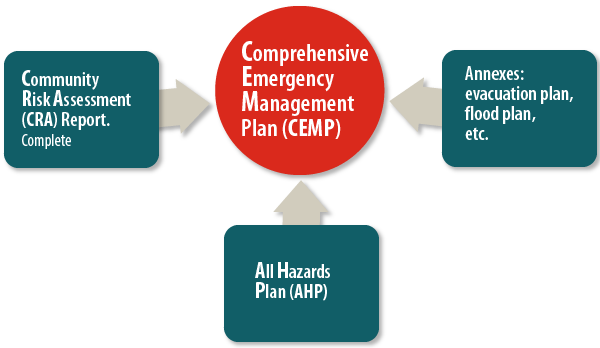Comprehensive Emergency Management Plan
What is a Comprehensive Emergency Management Plan (CEMP)?
Comprehensive and integrated emergency management is a shared responsibility between all levels of governments, the private sector, non-governmental organizations and individual citizens. A review of the existing District of Squamish Emergency Plan found that it was outdated and had several gaps.
As the community of Squamish is experiencing unprecedented growth that is projected to continue to 2031 and potentially beyond, it is timely to develop, implement and practice all necessary emergency management plans to safeguard the growing populace and meet municipal legislative obligations.
The community of Squamish is exposed to 16 unique hazards as identified in the District of Squamish’s Community Risk Assessment report (2015)—click here to view.
The CEMP will build on the Community Risk Assessment Report (2015) which is designed as the first step in guiding practical preparedness, response, recovery and mitigation actions that reduce both the likelihood of emergencies and the consequences when disaster cannot be avoided.
The development and use of a CEMP is mandated by the British Columbia Local Authority Emergency Management Regulation (1995), 2(2) whereby:
Each municipal council and each board of a regional district that qualifies as a local authority under section 2 (1) of the Act must reflect in its local emergency plan, unless it is documented elsewhere,
(a) the commitment of the local authority to provide policy guidance and direction to the emergency management organization established by that local authority under section 6 of the Act, and
(b) the procedures by which that guidance and direction is to be provided.
Consistent with federal and provincial emergency management structures, the CEMP will follow an ‘all hazards approach’ meaning that the same management strategies and emergency response structure are used to respond to any major emergency or disaster within the community regardless of the cause.
A CEMP is designed to be utilized as a “tool box” where each department or staff member of the District of Squamish may apply the specific sections of the plan to their operations during a major emergency or disaster.
CEMP Structure

Timeline
The CEMP Project began in the spring of 2015 and will continue until winter of 2016. The CEMP will be delivered in a staged process.
Stage One: Community Risk Assessment (complete)
- Identify community hazards, risks and vulnerabilities
- Identify priorities and establish plans and strategies that effectively protect the people and assets of Squamish
Stage Two: All Hazard Plan
- An outline of the DOS’s authority and responsibilities to act in major emergencies and disasters
- An understanding of the authorities, working relationships, responsibilities and functions of municipal government, senior levels of government and various support organizations relative to a major emergency or disaster
- Optimization of the management of response operations including activation of the Emergency Operations Centre (EOC), coordination of multi-jurisdictional activity, and mobilization of critical resources
Stage Three: Annexes, including:
- Guidance for the continuity of municipal government in a major emergency or disaster
- A description of actions the community should take to mitigate losses
- Detail plans for the initiation of orderly and controlled evacuations of local residents and visitors to the community, as deemed necessary
- Detail plans to ensure that evacuees are provided with essential services including shelter, food, clothing, first aid, family reunification and emotional support
- Detail plans to expedite the restoration of essential services and critical facilities as soon as practicable
- Detailed hazard specific plans, e.g. flood, earthquake, interface fire
Project Team
The CEMP Project Team consists of representatives from key Departments. Subject Matter Experts are being used for important areas (i.e. evacuations, crisis communications etc.).
